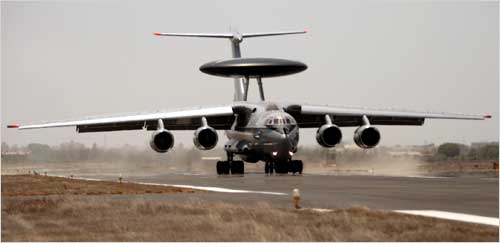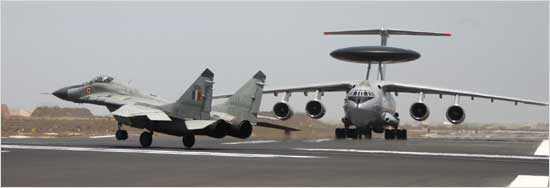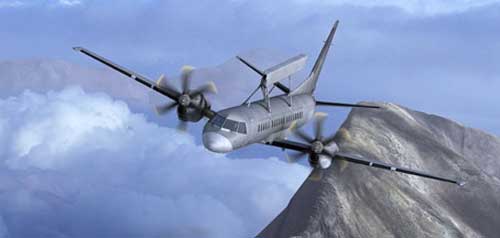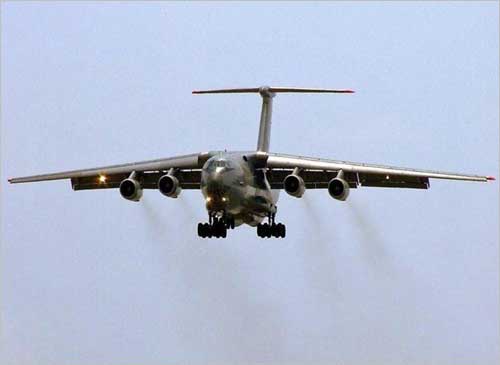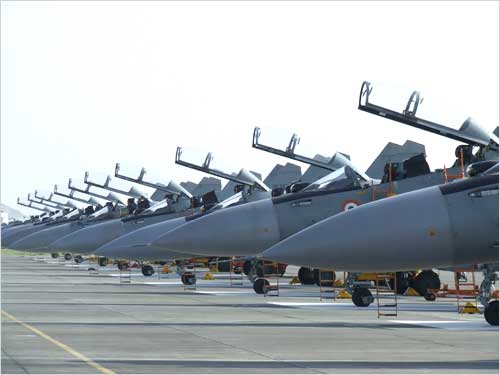 | « Back to article | Print this article |
AWACS will alter our dynamics like never before
M P Anil Kumar, a former IAF fighter pilot, looks at how it will redefine battlefield surveillance, and totally revolutionise the IAF.
The armed forces for defence, not aggression. This Indian military philosophy has received further boost with the induction of the first Airborne Warning and Control System (AWACS) into the Indian Air Force.
This IAF AWACS is an Indo-Russo-Israeli hybrid; the Israeli Phalcon radar is mounted on a Russian Ilyushin-76TD aeroplane. The airframe and its engines have been done up to suit the Indian clime.
The phenomenal capability and capacity of Sukhoi-30 MKI fighter aircraft inducted roughly a decade ago had compelled the IAF strategists to breathe fresh dimensions into fighter operations.
Now the induction of AWACS is set to redefine battlefield surveillance, and it will totally revolutionise the way IAF operates, and will definitely alter the strategic dynamics of our part of the world, like never before.
A quick glance in the rear-view mirror
Radar, an acronym for radio detection and ranging, is a system used for detecting the range, altitude and velocity of moving (even stationary) objects like aircraft and ships, from the echo produced by pulses of high-frequency electromagnetic waves.
Though invented in the early twentieth century, radar came into its own during the Battle of Britain (in the summer and autumn of 1940). Backed by an array of ground-based radars, the fighter command of the Royal Air Force thumped the Luftwaffe, and turned the tide, which eventually led to the rout of the Germans.
Even today many believe it was the humble radar, far more than the shock-and-awe atom bomb, that contributed to the Allied victory in the Second World War. Radar rewrote the art of war and thus became a game-changer.
This leap in technology made life difficult for the pilots, but military aviators, a resourceful lot, bounced back by flying low to evade radar detection. Thus began, true to every human endeavour to forge ahead by outwitting the other side, a riveting cat-and-mouse game of detection and evasion.
Jammers, infrared sensors, aerostat and over the horizon radars, stealth technology, unmanned aerial vehicles, AWACS -- the works -- arose out of this competitive evolution. The technologically advanced forces continued to hold sway, and AWACS turned itself into a game-changer.
AWACS, a primer
AWACS is essentially a radar mounted on an airborne platform that looks down from an approximate operating altitude of 30,000 feet. Fixed atop the fuselage is a big discus-like dome known as radome, which houses the radar antenna.
In earlier versions, the radar mechanically rotated with the dome, and in that era, many preferred to refer to the radome as rotodome.
Initially the system was designed for early warning and surveillance, and hence it was called AEW (airborne early warning), the prime example being the American Grumman E2C Hawkeye. Later, the improved versions of AEW came to be known as AEW&C (airborne early warning & control).
The term AWACS was coined with the entry of Boeing E3A Sentry. The convention now is to call aircraft with lesser endurance and lesser number of operators on board like the Israeli Gulfstream project or the Embraer project as AEW&C, while the big fellows like the Boeing Wedgetail or IL-76-based system have appropriated the nomenclature AWACS.
AWACS is an unsurpassed force-multiplier
Tasked to the Centre for Airborne Systems (CABS), Bangalore, the Indian quest for AEW capability began in July 1985 under Project Guardian. Later renamed Airawat, the airborne platform chosen was Avro HS-748 fitted with rotodome-based radar. There was obviously a structural mismatch and on January 11, 1999, we paid the price; the aircraft crashed killing four top boffins and four IAF crew (including my friend Squadron Leader N V Seshu). That brought an abrupt end to Airawat.
Meanwhile, the Indian Navy, the undisputed leader in indigenisation among the three services, operationalised an AEW system on a fleet of nine Kamov-31 helicopters.
After obtaining the American nod, India turned to Israel for the supply of Phalcon, and inked a $1.1 billion deal for three systems. In August 2005, CABS was resurrected and given charge of raising AEW&C system on Brazilian Embraer EMB-145 aeroplane, hopefully with an indigenous derivative of the Swedish Erieye radar (formerly Ericsson, now SAAB Microwave Systems).
The Indian Navy has signed a contract with Boeing for six P-8I Poseidon long-range reconnaissance aeroplanes, which when commissioned will immensely enhance India's maritime reconnaissance capability. These aircraft will be data-linked with the whole caboodle of surveillance assets.
Bang for the buck
As regards the IAF AWACS, the state-of-the-art Phalcon inside the stationary radome uses the active phased-array electronic scanning technology that steers the radar beams electronically to cover 360 degrees.
Such a circular sweep from high altitude enables the Phalcon beams to survey almost 800 km diametrically. Compared to the rotating antenna, the Phalcon has better reaction time, supports the tracking of highly manoeuvrable targets and spotting low-flying objects under all weather conditions, day and night.
The Phalcon is also capable of transmitting verification beams to omit false alarms.
Force-multiplier is an oft-used military term referring to a capability that significantly increases (hence 'multiplies') the combat effectiveness of a military force. AWACS, the cliched 'eye in the sky,' is an unsurpassed force-multiplier.
Flying at an altitude of 10 km, the Phalcon has a maximum detection range of 400 km. It is outfitted for tactical surveillance of surface and airborne targets, can track and monitor upwards of 60 targets simultaneously, which include enemy fighters and incoming missiles.
It can watch ground troop movements with an eagle eye. It is kitted with an IFF (Identification of Friend or Foe) suite, as the name suggests, to differentiate between own and enemy forces. And it eavesdrops too.
Planning and executing a successful military task hinge on sharp surveillance and gathering real-time operational intelligence. The Phalcon data streaming in from all the sensors are pieced together to form a comprehensive electronic picture, which can be used by the field commanders to make real time assessments and decisions.
For instance, if the enemy launches an air raid or an armoured foray, the AWACS will espy it and transmit that piece of information to the field commanders, real time, who then can launch fighters from the nearest airbases to shoot down the enemy aircraft or pulverise the enemy armour, thus boosting our defensive capability.
Can a parity-obsessed Pakistan be far behind?
Rash neglect by successive governments has resulted in the steady erosion of the IAF's quantitative, and qualitative edge.But the entry of AWACS will ensure the optimal use of dwindling IAF assets. This is force-multiplication. (By making a grim situation look good, the AWACS makes up somewhat for governmental callousness!)
Moreover, when our own fighters are launched, AWACS can guide them up from the heavens, which means the fighters need not 'illuminate' their onboard radars until the terminal phase of their mission, thus minimising the chance of their detection.
The Phalcon also doubles up as an ELINT (electronic intelligence) and COMINT (communication intelligence) aircraft. Soon we should be able to add SIGINT (signal intelligence) to these capabilities, which could then be utilised to snoop on and monitor even terrorist groups.
This convergence of ELINT, COMINT & SIGINT on to a single platform that is already brimming over will obviate the need to operate specialised craft for these tasks. This is another example of force-multiplication.
Further, two AWACS working in conjunction with our grid of aerostat radars can more or less scan and monitor Pakistani activity from well within Indian airspace.
The air forces the world over set urgent store on 'blinding' the enemy by targeting its 'electromagnetic eyes', ie, the radar systems. Given the pivotal role of AWACS, the enemy will repeatedly mount concerted attacks to take out the AWACS. Because of this serous threat, it often patrols approximately 100 km away from the battlefront.
Of course, the AWACS is kitted with its own defensive survival mechanisms but it still needs to be protected by airborne fighters. Since these are operational details, I shall not spell out how much assets the IAF will have to commit to shield the AWACS.
Neighbourhood watch
China: In 1994, China initiated negotiations with Russia and Israel for mounting the Phalcon on Russian-made Beriev A-50I but the Clinton administration vetoed it later. Snubbed, China embarked upon an ambitious domestic programme.
According to the Sino-Defence Web site, four systems -- one on A-50I and three on IL-76MD transports -- were contrived by installing the homegrown Nanjing 14-made airborne radar system, and it entered operational service between 2006 and 2007 with the People's Liberation Army Air Force (PLAAF).
The PLAAF calls it Kong Jing-2000, KJ-2000 for short. At best, the Chinese-made electronically steered phased array radar could be a notch below the Phalcon.
An experimental Chinese AWACS reportedly crashed in 2006, killing their best scientists and technicians. China is consequently pursuing the project on Boeing 737-800 airframe.
Pakistan: If India acquires AWACS, can a parity-obsessed Pakistan be far behind? Since every US administration loves to indulge the Pakistani military, American presidents turn into sugar-daddies and pamper Rawalpindi with chequebooks.
Hence wherewithal is never a stumbling-block in the Pakistani pursuit to seek parity with India.
As nobody was willing to sell them top-of-the-shelf AWACS like the Phalcon, they have settled for six Erieye surveillance radars fitted on Swedish SAAB-2000 turbo-prop aeroplanes. They expect the delivery to commence this year-end. As for performance, these are comparable to India's homegrown AEW&C.
With the Phalcon's superiority an unarguable fact, Pakistan has turned to its all-weather friend China to acquire an undisclosed number of KJ-2000s. It will surprise nobody if China obliges its stooge Pakistan, not only to counter India but also to defray the huge developmental costs the Chinese project incurred.
We need six AWACS to patrol our entire unfriendly neighbourhood
Once we bring both China and Pakistan into the equation, we will need at least six AWACS to patrol our entire unfriendly neighbourhood. Therefore, the IAF is keen on acquiring three more Phalcons.
The CABS-made AEW&C is expected to complement this fleet of Phalcons, and on paper, these are scheduled to materialise in 2012. (A caveat: since it is a DRDO-endeavour, one cannot discount that institutionalised DRDO speciality -- cost and time overruns!)
With the future hinging on network-centric warfare, establishing the hard-wiring essential for network centricity is progressing apace. Network centricity involves the linking and synergising of ground and aerospace-based assets to enhance the situational awareness of both air and ground theatre commanders, so as to enable them to expedite decision-making.
The AWACS is going to be the kingpin around which the other network-centric-warfare elements will coalesce.
The IACCS (Integrated Air Defence Command and Control System), which is nearing completion in terms of both hardware and software, will interlink all ground-based and airborne radars (AWACS, aerostat and UAV).
This will also knit together disparate Russian and western radars. The IACCS also takes care of the whole gamut of C4I2 functions -- Command, Control, Communications, Computers, Intelligence and Interoperability.
The AFNET (Air Force Network) is a dedicated IAF fibre-optical network that offers up to 500 MBPS encrypted, unjammable bandwidth. This bandwidth should be more than enough for IAF's current and foreseeable requirements of network activity, viz. air defence, administration, logistics, UAV imagery, high definition video streaming.
The third segment of the triptych is the Operational Data Link -- very similar to the Link 16/22 of NATO -- which will link up all the airborne platforms.
The IAF had originally envisioned IACCS for nuclear C2 (Command and Control) too, but bureaucratic pettiness torpedoed it. When will the babu grow up? Whatever, it will be fascinating to see how the command and control structure evolves as our armed forces gear themselves up for network-centric warfare.
As per media reports, a military satellite is expected to be launched next year, inter alia, to streamline the massive data flow. Needless to add, the country needs an inter-services data link programme to enable instant exchange of battlefield information to synergise the nerve-centres of the three services.
Although some IAF elements have operated under the AWACS environment, the IAF will have to devise its own AWACS strategies. Having the AWACS afloat is one thing, the actual assimilation of AEW capabilities for making fighter operations lethal is quite another, and that is going to challenge the IAF leadership.
While India gingerly began to take baby steps today, the past masters US and UK are galloping ahead in this game of airborne battle management, command & control, via USAF's E-8 Joint Surveillance Target Attack Radar System (Joint STARS) and RAF's Sentinel R1 Airborne Standoff Radar (ASTOR) programmes.
With our part of the world set to be awash with AWACS beams soon, it will all boil down to identifying threats swiftly and dealing with it promptly. Since our adversaries too are AEW-capable, reaction-time and missile capabilities are going to decide the winner in this quickest-on-the-draw game.
It is no secret that the Chinese have better missiles. The ministry of defence needs to reinforce the IAF arsenal with deadlier missiles.
More power to the Indian Air Force!
Given our growing global weight, our aspirations, our economic and geopolitical interests, not just elongating the outreach of our military but power projection too has become an imperative.
To fulfil this, the old Indian military philosophy -- armed forces for defence -- has to mutate, of course with characteristic Indian subtlety. Future military historians, in all likelihood, will pinpoint the IAF AWACS as the mindset-changer, and the game-changer.
The last word comes from a former squadron-mate and a dear friend. Now an IAF whiz-pro, he is a fierce believer in the Sun Tzu axiom of attaining victory without a war. It agitates him no end if someone utters that bureaucratic gem 'defence expenditure.'
"It is defence investment," he belabours to correct the offender, and buzzes off by affirming that the returns on 'defence investment' is peace and stability. Who can disagree with his logic? If only the government too understood it.
More power to the Indian armed forces!
Tailpiece: One of the most astounding hit missions executed by the formidable combo of Mossad and Israel defence forces was carried out on April 16, 1988. Ian Black and Benny Morris (co-authors of Israel's Secret Wars) described it as 'a ruthless operation of unsurpassed technical brilliance that combined thorough intelligence with flawless execution.'
Ehud Barak led a seaborne commando operation to bump off Fatah co-founder and military commander Khalil Al Wazir -- better known as Abu Jihad and deputy to Yasser Arafat -- at his very refuge in Tunis. The whole operation was coordinated from a Boeing 707, converted into an AWACS, flying over the Mediterranean Sea!
Not just that; this AWACS jammed all the communication lines in Abu Jihad's locality. The Israeli audacity, ingenuity and single-minded pursuit of quarries will never cease to amaze me.
